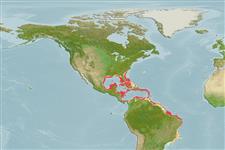>
Eupercaria/misc (Various families in series Eupercaria) >
Labridae (Wrasses) > Bodianinae
Etymology: Bodianus: Bodianus after Bodiano or Pudiano, from the Portuguese pudor, meaning modesty (Jordan & Evermann, 1896).; rufus: Name from a Latin adjective meaning 'red' or 'reddish', apparently in reference to the overall reddish yellow coloration of some large individuals of this species. Believed to have been based on Catesby’s (1743) colour figure of this species referred to in Linnaeus’ original description of Labrus rufus, however, the initial-phase adult of B. insularis is also completely red (Ref. 75973).
More on author: Linnaeus.
Environment: milieu / climate zone / depth range / distribution range
Ecología
marino asociado a arrecife; rango de profundidad 1 - 70 m (Ref. 9710), usually 3 - 70 m (Ref. 27115). Tropical; 22°C - 28°C (Ref. 27115); 33°N - 26°S, 98°W - 34°W
Western Atlantic: Bermuda, southern Florida (USA) and throughout the Gulf of Mexico and Caribbean Sea to southern Brazil.
Tamaño / Peso / Age
Maturity: Lm ? range ? - ? cm
Max length : 40.0 cm TL macho / no sexado; (Ref. 9626); common length : 28.0 cm TL macho / no sexado; (Ref. 3726); peso máximo publicado: 1.0 kg (Ref. 40637)
Espinas dorsales (total): 12; Radios blandos dorsales (total): 9-11; Espinas anales 3; Radios blandos anales: 11 - 13. Head, upper front part of body, and front of dorsal fin blue if from shallow water, red if from deep; rest of body and tail yellow. Dorsal, anal, and pelvic fins mostly blue or red-yellow at rear (Ref. 26938).
Adults inhabit rocky or coral reefs (Ref. 9710). Feed on brittle stars, crustaceans, mollusks, and sea urchins (Ref. 9710). Juveniles actively pick parasites from larger fishes (Ref. 5521). A protogynous hermaphrodite (Ref. ). Oviparous, distinct pairing during breeding (Ref. 205). May hybridize with spotfin hogfish, B. pulchellus (Ref. 40096). Marketed fresh (Ref. 3726). Maximum depth reported from Ref. 27115.
Life cycle and mating behavior
Madurez | Reproducción | Puesta | Huevos | Fecundidad | Larva
Oviparous (Ref. 205). Forms permanent harem groups composed of a single male and several smaller females (Ref. 55398). Monandric species (Ref. 55398). Sex reversal is completed in 7-10 days (Ref. 34185, 34247). Length at sex change = 17.28 cm TL (Ref. 55398). Spawning occurs at dusk (Ref. 55398).
Robins, C.R. and G.C. Ray, 1986. A field guide to Atlantic coast fishes of North America. Houghton Mifflin Company, Boston, U.S.A. 354 p. (Ref. 7251)
IUCN Red List Status (Ref. 130435)
Threat to humans
Reports of ciguatera poisoning (Ref. 30911)
Human uses
Pesquerías: escaso valor comercial; Acuario: Comercial
Más información
ReferenciasAcuiculturaPerfil de acuiculturaRazasGenéticaElectrophoresesheritabilidadEnfermedadesProcesamientoNutrientsMass conversion
Herramientas
Special reports
Download XML
Fuentes de Internet
Estimates based on models
Preferred temperature (Ref.
123201): 23.5 - 28, mean 26.7 °C (based on 620 cells).
Phylogenetic diversity index (Ref.
82804): PD
50 = 0.5000 [Uniqueness, from 0.5 = low to 2.0 = high].
Bayesian length-weight: a=0.01202 (0.00693 - 0.02085), b=3.06 (2.90 - 3.22), in cm total length, based on LWR estimates for this species & Genus-body shape (Ref.
93245).
Nivel trófico (Ref.
69278): 3.7 ±0.2 se; based on diet studies.
Resiliencia (Ref.
120179): Medio, población duplicada en un tiempo mínimo de 1.4-4.4 años (Preliminary K or Fecundity.).
Fishing Vulnerability (Ref.
59153): Low to moderate vulnerability (30 of 100).
Nutrients (Ref.
124155): Calcium = 41.9 [26.0, 67.6] mg/100g; Iron = 0.542 [0.325, 0.951] mg/100g; Protein = 18.6 [15.8, 20.8] %; Omega3 = 0.146 [0.100, 0.213] g/100g; Selenium = 33.5 [21.2, 55.4] μg/100g; VitaminA = 101 [33, 355] μg/100g; Zinc = 1.23 [0.89, 1.86] mg/100g (wet weight);
